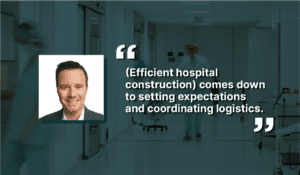How to Keep Hospital Construction Sites Safe … for Workers and Patients
Safety on construction sites involves more than hard hats and steel-toed boots.
Particularly on renovation and expansion of existing healthcare facilities, safety has to be considered for the patients and employees within the hospital, not just the construction workers.
With a collaborative construction project management information system (PMIS), all data is digitized and accessible, available in real time to all stakeholders. And shared, up-to-date info is key to safe work sites.
OnIndus – a member of the Kahua Partner Network – works to improve processes and outcomes of capital projects for construction professionals, and it has worked with multiple owners in the health care industry. Bret Elam is a capital program advisor and senior manager for healthcare with OnIndus; he also worked for 15 years overseeing construction projects for a healthcare provider, so he is well acquainted with the need to not adversely impact patients while expanding and improving facilities.
For Construction Safety Week, we talked to Elam about how to accomplish that. He said these projects create an interesting dynamic because the inherent nature of construction admits risk into a hospital.
 “It’s like two opposing forces working against each other,” Elam said. “You’ve got one force that is introducing dust and disruption, and the other force is promoting an environment of calm and care. If not handled properly, our presence can negatively impact healthful outcomes. It is paramount that does not happen.”
“It’s like two opposing forces working against each other,” Elam said. “You’ve got one force that is introducing dust and disruption, and the other force is promoting an environment of calm and care. If not handled properly, our presence can negatively impact healthful outcomes. It is paramount that does not happen.”
Elam said the most critical aspect for construction partners to keep top of mind when working in healthcare settings is to understand the business processes and controls that need to be in place. They must make sure they are communicating with key personnel to review safety plans and risk assessments to ensure proper approvals.
“The whole point of digitalization is so that you can transparently communicate to multiple parties on this is where we will be working, and this is where we won’t,” he said. “That’s critical in health care because while the risk assessments in the plans might be vetted by a smaller group of people, they impact a broad group of people.”
Elam said there are typically many more expansion/renovation projects than new builds in health care. And most of those are in urban settings where there’s a finite amount of available land. Construction could be occurring adjacent to a neonatal intensive care unit or below an operating room, where vibration and noise are unwelcome.
“It comes down to setting expectations and coordinating logistics,” he said. “Patients need to be able to sleep and rest to get better. It’s a big part of how the body heals itself.”
Elam recalled a sensitive project when the hospital was demolishing a wing below an intensive care unit. He had twice daily checkpoints with the superintendent and nurse manager to discuss progress and expectations.
And digitizing those processes kept all stakeholders informed. It’s how to make sure there’s always functioning sprinklers in every part of the occupied hospital and providing the proper amount of separation between construction debris and patients.
In many hospitals, there might be 12 or 15 projects going on at any one time. While there might be multiple project managers, there’s likely only one safety team or infection control team that’s overseeing efforts. And that can create a bottleneck, he said.
“So, it’s our job to understand the business process and help make those more visible so that individuals can get those requests digitally,” Elam said. “And then they have access to dashboards and reports where they can see where the open projects are.”
When asked about the latest trends in healthcare construction, Elam said the COVID-19 pandemic illuminated a need to make hospital spaces potentially multipurpose, such as the capacity to create areas with both positive and negative air pressure capabilities.
“COVID created a moving target in the early days, and I think it was then we discovered how quickly we could actually make things happen,” he said. “And as renovations or new builds are being designed, we need to be thinking of now just the care model that exists today, but how could it be adaptable for the future.”
